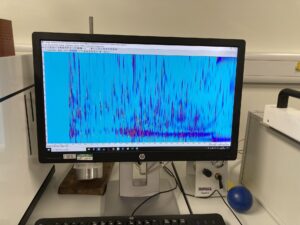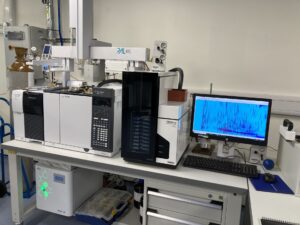Our test tells you which everyday chemicals you've recently come into contact with, and easy steps you can follow to reduce your exposure to them.
Indoor Air Quality study at the University of Leicester

In the UK more than 8 million people suffer with symptoms of asthma, higher than all other lung related health conditions combined. It affects all ages, and even though many children grow out of it, more than 5.4m people receive ongoing treatment for this condition at a cost of around £1 billion a year for the NHS.
In recent years air pollution was been attributed for the first time as a cause of death to a young girl who lived alongside a busy road in London, but much less is known about the potentially harmful effects of poor indoor air quality.
On National Clean Air Day we’re delighted to share a new study investigating indoor air exposures to volatile organic compounds (VOCs) and fungi spores, and the relationship they might have with severe asthma. The study based at Leicester University’s Centre for Environmental Health and Sustainability is a research project led by PhD student Thiphanie Riveron.
She is trying to find out if asthmatics who live in homes with high exposures to moulds and volatile organic compounds (VOCs) might report greater symptoms and, or increases in the severity of their symptoms.
How healthy is indoor air?
We spend up to 90% of our time indoors, so the air we breathe inside can lead to long-term exposure to poor air quality with the potential to impact health. In our homes and workplaces we are exposed to volatile organic compounds that are emitted from a wide range of products such as furniture, fragrances, personal care products, paints, and also from outside as car emissions.
VOCs can move around our homes as airborne particles, floating in the air. Short term, higher level exposure to VOCs have already been connected with headaches, nausea, respiratory tract irritation, and irritation to the eyes. Long term exposure health risks are more serious, and include nasal cancer, leukaemia, cancer of the lung, and neurological effects.
Taking science outside the laboratory and into the home
In her study Thiphanie has set out to collect airborne particles from inside people’s homes in everyday settings. The first phase of the study began in Spring 2021 when Thiphanie began gathering data to characterise the chemical composition of indoor air in four residential properties. She collects samples using an active method in which air is drawn through a tube using a specific pump. Samples are taken at different times during the week, at weekends, and across different rooms in each house.
The tubes made metal, contain sorbents to collect the pollutants in each room, while fungi are collected on special filter material. The sampling kit consists of pumps and tubes, and look unremarkable, but what happens next is state of the art environmental science.
How are air quality samples analysed?
First, the tubes are run through a thermal desorption that removes the chemicals from the inside of the tubes. Then the chemicals are injected into a gas chromatography which separates the chemicals depending on their proprieties. The third step is to identify and quantify the chemicals using a flame ionization detector.
When this is all complete the data are run through a complex software analysis to interpret the data. It takes five days to detect and analyse the chemicals for a house (it’s around 2 hours for a tube) and a further two weeks for Thiphanie to analyse and interpret the results.
In total 300 VOCs can be detected, and each mark on the chromatogram denotes a VOC that’s been detected. VOCs can be seen in 3D image as well as a flat screen. VOCs such as benzene, styrene, xylene, and limonene are amongst the VOCs that be detected with this method. The levels of these and other VOCs are then compared to UKHSA* guidelines for safe levels of VOCs.


The chromatogram represent the VOCs present in a house. Each peak is a VOC, bigger the peak, the higher is the concentration in the house.
Controls and variables in the study
Houses have been selected in a variety of settings including rural, urban, near busy roads, and city centres. Differences such as cooking fuels, ventilation methods, and glazing are all being considered. One further home (not included in the main study) with a full home ventilation system will also be monitored for interest.
What’s been found so far?
The study has already found some early indicators that one particular VOC, D-limonene, peaks during the early evening when it’s most likely that evening meals are being cooked. Levels are 50 times higher after cooking.
D-limonene is one of the substances included in the UKHSA guidelines, and although it doesn’t have a serious impact on human health, it can lead to eye and throat irritation. Levels detected have seen massive increases, demonstrating the impact of human activities on VOCs concentrations. D-limonene is a common ingredient in many personal care products.
Of the data analysed for the first four houses, a house nearest to a busy road was found to have the highest levels of VOCs related to car emissions detected, suggesting that factors such as ventilation and windows could be contributing.
The next phase of the study
In phase two of the study a further 18 houses will be tested. A paper to present the findings of this phase of the study will be shared with the scientific community. This will be of real public interest, that’s why we’re featuring it now, and will track its progress over the next phases of the project.
More about Thiphanie
Before arriving in the UK Thiphanie studied for a master’s degree in immunology at the University of Nantes, and a masters in Epidemiology at the University of Bordeaux. She joined the Centre for Environmental Health and Sustainability as a full time PhD Student in January 2021. She told us. “I applied to this PhD because it could directly impact on people’s lives. The study outcomes could help shape advice on indoor air quality in people’s homes.”
She says that we should all consider changing one small thing to improve the indoor quality in our homes, such as using fewer scented products, or improving our ventilation by opening our windows more often.
How might this study inform public health?
The Centre for Environmental Health and Sustainability (CEHS) is one of the newest faculties at the University of Leicester. The chemistry facility sits with an impressive part of the Space Park Leicester campus; it’s a building of high ceilings, wide blue corridors, and workspace laboratories with space-age looking equipment where science collides with everyday life. Founded in 2018, the CEHS is an initiative to develop new areas of research that build on existing work in the environment, health, and sustainability. The vision of CEHS is to improve human health, and the health of the environment, through cutting edge multidisciplinary research, in a changing world.
This study is an example of science in action; researchers working with government teams to make a real-world difference to our future public health. One of the wider aims of the department is the ambition to help make improvements to guidelines on future building regulations that will improve public health. Thiphanie’s project is one of many in progress at the university, but the only one focused on exposures to VOCs and fungi in the home.
Thiphanie’s research is conducted through the National Institute of Health Research (NIHR) Health Protection Research Unit (HPRU) at the University of Leicester, a research partnership between the University and the UK Health Security Agency, also involving the Health and Safety Executive.
Further reading: